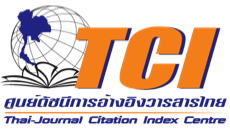บรรยากาศองค์การกับประสิทธิผลของโรงเรียน สังกัดสำนักงานเขตพื้นที่การศึกษามัธยมศึกษา เขต 3 (Organizational Climate and School Effectiveness of School Under Secondary Educational Services Area Office 3)
คำสำคัญ:
บรรยากาศองค์การ, ประสิทธิผลของโรงเรียนบทคัดย่อ
การวิจัยครั้งนี้ มีวัตถุประสงค์เพื่อทราบ 1) บรรยากาศองค์การของโรงเรียนสังกัดสำนักงานเขตพื้นที่การศึกษามัธยมศึกษาเขต 3 2) ประสิทธิผลของโรงเรียนสังกัดสำนักงานเขตพื้นที่การศึกษามัธยมศึกษาเขต 3 3) ความสัมพันธ์ระหว่างบรรยากาศองค์การกับประสิทธิผลของโรงเรียนในสังกัดสำนักงานเขตพื้นที่การศึกษามัธยมศึกษาเขต 3 กลุ่มตัวอย่าง ได้แก่ โรงเรียนจำนวน 44 โรง ผู้ให้ข้อมูลโรงละ 4 คน ประกอบด้วย ผู้อำนวยการโรงเรียน 1 คน รองผู้อำนวยการโรงเรียน 1 คน หัวหน้ากลุ่มสาระการเรียนรู้ 1 คน และครู 1 คน รวมผู้ให้ข้อมูล 176 คน เครื่องมือที่ใช้เป็นแบบสอบถามเกี่ยวกับบรรยากาศองค์การ ตามแนวคิดของโฟร์แฮนด์ และประสิทธิผลของโรงเรียนตามแนวคิดของฮอยและมิสเกล สถิติที่ใช้ในการวิเคราะห์ข้อมูลคือ ความถี่ ร้อยละ มัชฌิมเลขคณิต ส่วนเบี่ยงเบนมาตรฐานและการวิเคราะห์สัมประสิทธิ์สหสัมพันธ์ของเพียร์สัน ผลวิจัยพบว่า 1) บรรยากาศองค์การของโรงเรียน ในภาพรวมอยู่ในระดับสูง เมื่อพิจารณาเป็นรายด้านพบว่าอยู่ในระดับมาก 4 ด้าน โดยเรียงลำดับค่ามัชฌิมเลขคณิตจากมากไปน้อย ดังนี้ เป้าหมายขององค์การ เครือข่ายของการติดต่อสื่อสาร แบบของความเป็นผู้นำ ความซับซ้อนของระบบ ยกเว้นด้านขนาดและโครงสร้างขององค์การอยู่ในระดับปานกลาง 2) ประสิทธิผลของโรงเรียน ในภาพรวมอยู่ในระดับมากโดยอยู่ในระดับมากทั้ง 4 ด้าน ดังนี้ ความสามารถในการปรับตัว ความสามารถในการพัฒนาศักยภาพ ความสามารถในการผลิตนักเรียนที่มีผลสัมฤทธิ์ทางการเรียนสูงและลำดับสุดท้ายคือ ความสามารถในการผสมผสาน 3) บรรยากาศองค์การกับประสิทธิผลของโรงเรียนสังกัดสำนักงานเขตพื้นที่การศึกษามัธยมศึกษาเขต 3 มีความสัมพันธ์กันอย่างมีนัยสำคัญทางสถิติที่ ระดับ .01
เอกสารอ้างอิง
Anderw D. Szilagyi, Jr., and Marc J. Wallace, Jr., Organizational Behavior and Performation (California : Goodyear Publishing company, 1980), 344.
Andrew W. Halpin and Don B. Croft, The Organition Climate of School (Chicago: The University of Chicago press,1963),60-67.
Andrew W. Halpin and Don B. Croft, The Organization Climate of School (Chicago: University of Chicago, 1963),133-152.
Brian J. Caldwell and Jim M. Spinks, The Self-Managing School (London:Taylor and Francis,Printers,Ltd, 1990),5-12.
Car;d D. Glickman and others, Supervision and Instructional Leadership a Developmantal Approach (U.S.A: allyn and bacon, 2001), 49.
Chris Argyris, Integrating the Individual and the Organization (New York: John Wiley and Sons,1964),123.
Concepts ad Practices, 6th ed. (CA: Wadworth Publishing,2012),31-33.
Daniel Katz and Robert L. Kahn, The Social Psychology of Organization (New York : John Wiley and Sons,1966),19.
De Stefano Marcelo, “School Effectiveness: The Role of the Principal in a Leading Public Secondary School in Santa Fe Province, Accessed July 12, 2008,” Available from http://digitalcommons.libraries.columbia.edu/dissertations/AAI3091243/
Edgar H. Schein, Organization Psychology (Englewood Cliffs: New Jersey :Prenice-Hall Inc,1970),177.
Fred C. Lunenburg and Allan C. Ornstein, Educational Administration:
Garlie A. Forehand, “Assessments of innovative behavior: Partial criteria for the assrssment of executive performance,”Journal of Applied Psychology22 (1963): 206-222.
Garlie A. Forehand, “Assessments of innovative behavior: Partial criteria for the assrssment of executive performance,”Journal of Applied Psychology22 (1963): 206-222.
Garlie Forehand and von Haller Glimer, “Environment Variation and Studies of Organization Behavior”, Psychological Bullentin 62 (December 1964):361-382. Gary Dessler, Management fundamentals : A Framework (Virginia : Reston Publishing company, 1979), 334.
Gary Dessler,Organizational Theory: Intragating Structure and Behavior,2nd ed.,Englewood Cliff(New Jersey:Prentice-Hall,1986),68.
George H. Litwin and Robert A. Stringer, Jr., Motivation and Organization Climate (Boston, Division of Research, Graduate School of Business Administration, Harvard University, 1968), 81-82
George H. Litwin and Robert A. Stringer,Jr., Motivation and Organization Climate (Boston: Division of Research,Graduate School of Business Adiministration,Harvard University,1968),1968),371.
George Strauss and Leonard R. Sayles, Personnel : The Human Problem of Management (Englewood Cliffs, New Jersey : Prentice Hall Inc., 1960), 119-127.
Gibson, Ivancevich and Donnelly, Organizations : Structure, Processes Behavior, 526.
Gilbertand Austin and David Reynolds, “Managing for Improved School Effectiveness: An International Survey,” School Organization 10 no. 2/3 (1990).167-178.
Gopalaiyer Mohan, “Current Views of the Characteristics of School Effectiveness in the Context of National Secondary Schools form the Perceptions of Principals, Heads of Department and Teachers in Kuala Lumpur, Malaysia” (Ed.D. Dissertation University of Leicester, 2008), iii.
Hoy and Miskel, Educational Administration Theory Research and Practice, 297.
Jame C. Anderson and Francis B. Evans, “Causal Model in Educational Research : Recursive Model,” American Educational Research Jounal 2 (Winter 1974) : 29-39





